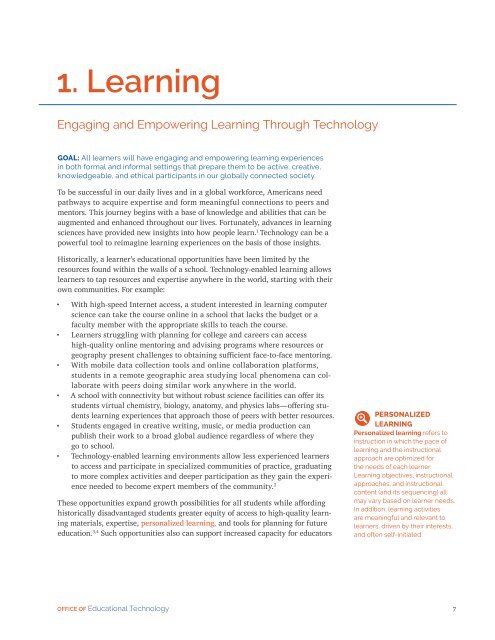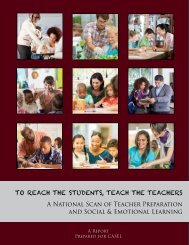Future Ready Learning
7m3sdJ
7m3sdJ
You also want an ePaper? Increase the reach of your titles
YUMPU automatically turns print PDFs into web optimized ePapers that Google loves.
1. <strong>Learning</strong><br />
Engaging and Empowering <strong>Learning</strong> Through Technology<br />
GOAL: All learners will have engaging and empowering learning experiences<br />
in both formal and informal settings that prepare them to be active, creative,<br />
knowledgeable, and ethical participants in our globally connected society.<br />
To be successful in our daily lives and in a global workforce, Americans need<br />
pathways to acquire expertise and form meaningful connections to peers and<br />
mentors. This journey begins with a base of knowledge and abilities that can be<br />
augmented and enhanced throughout our lives. Fortunately, advances in learning<br />
sciences have provided new insights into how people learn. 1 Technology can be a<br />
powerful tool to reimagine learning experiences on the basis of those insights.<br />
Historically, a learner’s educational opportunities have been limited by the<br />
resources found within the walls of a school. Technology-enabled learning allows<br />
learners to tap resources and expertise anywhere in the world, starting with their<br />
own communities. For example:<br />
• With high-speed Internet access, a student interested in learning computer<br />
science can take the course online in a school that lacks the budget or a<br />
faculty member with the appropriate skills to teach the course.<br />
• Learners struggling with planning for college and careers can access<br />
high-quality online mentoring and advising programs where resources or<br />
geography present challenges to obtaining sufficient face-to-face mentoring.<br />
• With mobile data collection tools and online collaboration platforms,<br />
students in a remote geographic area studying local phenomena can collaborate<br />
with peers doing similar work anywhere in the world.<br />
• A school with connectivity but without robust science facilities can offer its<br />
students virtual chemistry, biology, anatomy, and physics labs—offering students<br />
learning experiences that approach those of peers with better resources.<br />
• Students engaged in creative writing, music, or media production can<br />
publish their work to a broad global audience regardless of where they<br />
go to school.<br />
• Technology-enabled learning environments allow less experienced learners<br />
to access and participate in specialized communities of practice, graduating<br />
to more complex activities and deeper participation as they gain the experience<br />
needed to become expert members of the community. 2<br />
These opportunities expand growth possibilities for all students while affording<br />
historically disadvantaged students greater equity of access to high-quality learning<br />
materials, expertise, personalized learning, and tools for planning for future<br />
education. 3,4 Such opportunities also can support increased capacity for educators<br />
PERSONALIZED<br />
LEARNING<br />
Personalized learning refers to<br />
instruction in which the pace of<br />
learning and the instructional<br />
approach are optimized for<br />
the needs of each learner.<br />
<strong>Learning</strong> objectives, instructional<br />
approaches, and instructional<br />
content (and its sequencing) all<br />
may vary based on learner needs.<br />
In addition, learning activities<br />
are meaningful and relevant to<br />
learners, driven by their interests,<br />
and often self-initiated.<br />
OFFICE OF Educational Technology<br />
7



